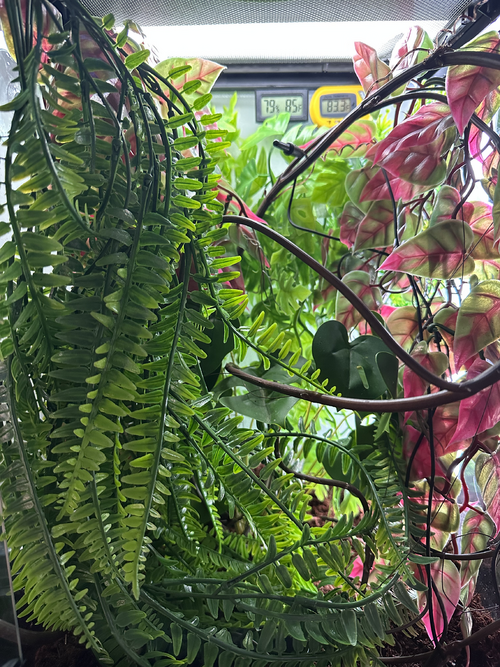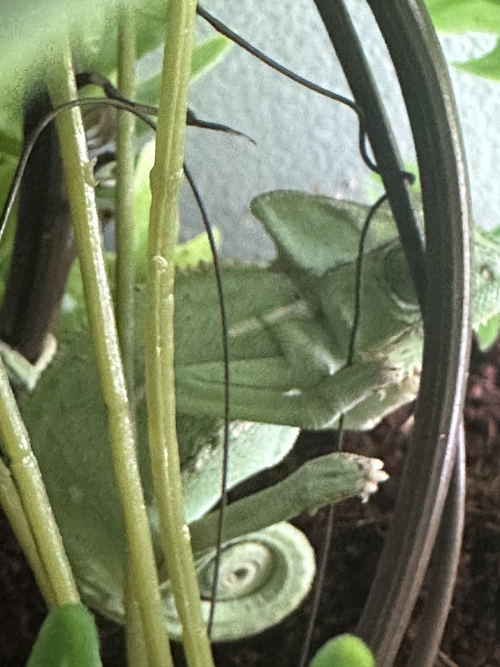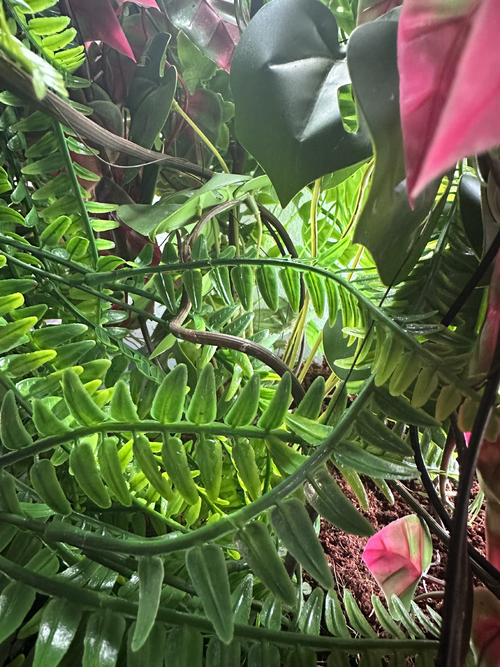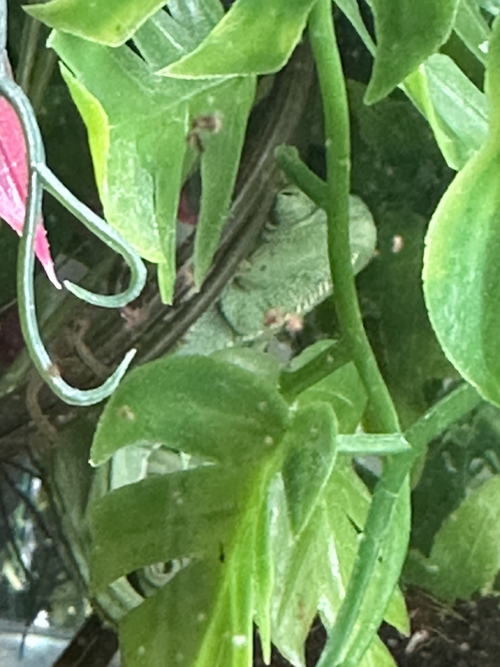painfultomato
New Member
** His eyes are not closed here due to me being in the cage, he is just looking downward. He also doesn't usually hang out in the corner like this but rather just random spots in cage, I had just fed him so he was basking but moved over when I opened the door **
So my chameleon has been stopping in random spots over the last few days with his eyes closed. I am not entirely sure what the issue is as this take setup seems to be just fine.
He does not look into the sky when he does it, not even once, so I am inclined to feel it isn't a sickness, as my very first chameleon suffered from this and would look into the sky and almost gasp for air. I still have lots of medicine for this, as the vet provided a lot lol.
Secondly, he isn't really turning black ever, he still maintains his pretty colors.
I am not sure if this could be a vitamin deficiency or not. I do lightly dust crickets with vitamins on each feeding, so maybe I am just not doing it right? If it is a vitamin deficiency, what are some recommended fruits etc for him?
Feeding is:
wax worms
meal worms
crickets
They are all dusted with calcium (no d3 and vitamins) each feeding. I usually do 10 - 25 crickets or 5 - 10 worms. (Usually all gone by next day)
Sundays they are dusted with calcium with d3 and vitamins with d3
No the reason I say usually gone by next day is that recently he hasn't been eating them all. I still have a handful of crickets in cage today as I am typing this.
Habitat size is 16" (~41cm) x 16" (~41cm) x 24" (~61cm) Height
Hybrid cage with full glass back, full glass front, half glass & half wire mess sides, and wire mesh top (Helps control humidity & temp)
Bedding is slight soil substrate with low moisture moss (Again humidity). This is not that coco whatever the heck (worried about compaction) more a fine kind of grassy plains idea in an attempt to simulate that of his native terrain. I can go into a lot of specifics of composition if it will help with finding out what is going on. As he relieves himself I tend to pick up droppings with a scoop that removes some of this. It is re-mixed bi weekly to prevent molds. Replaced entirely monthly.
habitat conditions (yellow thermometer is basking.
relative temperature sits around high 70's (~25°C)
basking is usually 87-88 (30-31°C)
Humidity is usually 75-80%
Night:
relative temp mid 60's to low 70's (18. - 22°C)
basking = relative
humidity mid 60's%
I use a non light heating element for night time heat adjustment
Usually only ambient light at night (very low level, non UVB)
He does not get moved or disturb while sleeping
When investigating he does not seem to have any indication of MBD. His grip is strong, he is very alert when I am around or opening his cage. He also is very alert when fresh food is insert. Not like a dart eyes around like a maniac alert, but from what I can tell looking around in a fairly smooth (as smooth as chameleons are usually) manner.
Now a few weeks back I left town for 4 days. This isn't usually a huge concern as his light cycles are all automated. I have sensors in the cage (not the ones in the picture) that are connected to an arduino to control his temperatures and humidity without the need of human intervention. However, in this particular instance a breaker had flipped (I am assume to some sort of surge as some really bad storms were happening at this time) and everything was shut off for this time period. According to the last known read he went a day and a half without any lighting, temp control, and humidity control. You may be asking, how was he fed. Again I had someone dropping by once daily to take care of feeding, however they couldn't on the day before last (except in the morning once) and not the last at all, in which I didn't arrive home until shortly before midnight. All light he had was coming from the window.
I didn't think much of it due to his normal nature for the week after, but idk. I am at a loss.
The log files for cage conditions don't show any abnormalities.
Oh, I totally forgot this. Humidity is controlled using a fogger. The water I use for this (and in the morning when spraying) comes from sealed filter spring water (minerals) and purified water (reverse osmosis) in a 75% spring 25% purified mix. When the sensors detect a drop of humidity below 70% during the day, the fogger will dial up (or on) quite a bit to bring that back up. At around 75% it dials back to kind of an idle and follows a curve of reduction if humidity continues to increase when approaching 80%. When going over 80% dials back much more and if hitting 83% will shutoff entirely, until 70% again. The reason for shutoff entirely is just incase there is some sort of malfunction or other factor causing the humidity to be increased quite significantly. This does not happen often however, as the program is designed to learn based off the past. When approaching lights off, this method changes. Fogger will dial back approx 1.5 hours beforehand. I say approx, because if we are sitting closer to 80% the number is closer to 2 hours, where if we are at lows 70's we are around 1 hour. This will drop back to the 60 - 65 % range.
Lighting will also begin to start dimming at one hour. This is fixed. This is on a basic fractional where every minutes light intensity reduces by 1.6% each minute, with the last minute turning off entirely. Since I have fade in and fade out light cycles, he is on a 14 hour cycle from on to off, with full exposure for 12.
Temperature works similarly. Again non light emitting temperature for the most part, unless I have some weird instance where temperature is significantly lower than usual, where I have a secondary light emitting heating element that will kick on to compensate. This is nice for two reason. First, if it's like winter and says some weird instance happens like a baseball goes through my window while I am not home and temperature starts dropping extensively. Secondly, says my non light emitting heating element burns out. Obviously I would have no idea until I personally look at the temp gauges in the cage, but an extra amount of light showing from his cage would be a pretty obvious indication that for some reason something is not right and I need to investigate. Now why not just do two non light heat elements? Personal fear that I may not notice primary is out and then secondary burns and there is a blizzard or something and I can't leave for several days (few years ago I had a puppy break his leg a few years back during a blizzard and I had to stint his poor little leg and wait two days before making it to an emergency vet where I had to pick the doc up and travel to the office as snow was still too bad to drive), so I want to know right away when it has gone bad asap.
I know this is a lot, but no other pets cross his path. I am the only living being he has direct vision of throughout the day, with an occasional other person once in a blue moon, as he is in my home office that is private and generally has the doors closed. I do not have a pupper anymore, sadly, nor any other roaming animals. I say roaming, because I have a smaller fish tank located just above my desk screens that has mainly shrimps and catfish. Just him and I live here.
Last, but not least, I spray once in the morning to simulate that morning due type of environment and get some good droplets on the plants etc. I know they like to wake up, feast, drink, then go chill in basking to let digest, this is why I do it this way.
Any tips, info, requests for more pics or anything? Maybe somebody has gone through similar and figured it out.
**** EDIT pretty sure it is a lighting issue. I took a 48" UVB light that has had maybe one hours time on it and set it vertically along the side of his tank. He is now sideways facing butt up on the edge of the tank right in front of the bulb with his one side slightly black. He is also opening his eyes and looking around every once in a while, not just when I am in his cage. I will be replacing his bulb soon. ****
Last edited:











